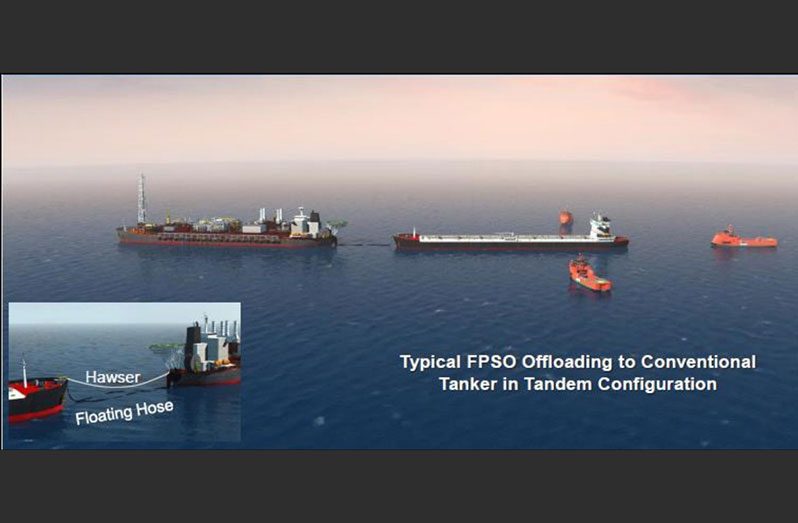— ExxonMobil’s fifth development project, Uaru, expected to produce up to 250,000 barrels per day
— company submits project proposal for environmental authorisation
OIL production offshore Guyana is slated for another boost in the near future as ExxonMobil moves ahead with plans for its fifth development project in the Stabroek Block, Uaru, which is expected to produce up to 250,000 barrels of oil per day.
The company, through its local subsidiary Esso Exploration and Production Guyana Limited (EEPGL), has submitted a proposal for that project to the Environmental Protection Agency (EPA), which will assess the document and grant environmental authorization, once the requisite criteria are satisfied.
According to the proposal seen by the Guyana Chronicle, the project will develop the Uaru, Mako and additional resources, if determined to be feasible and economically viable.
“Uaru Development Project will be designed to add up to 250,000 barrels of oil a day to existing daily production volumes in Guyana with the associated additional revenues to the Government of Guyana, while continuing a steady expansion of opportunities for Guyanese to participate in the petroleum industry,” the company said in its proposal.
Like the other Stabroek Block projects, the Uaru Development Project will involve drilling of production wells; installation, commissioning and operations of subsea umbilicals, risers and flowlines (SURF) and a floating production, storage, and offloading vessel (FPSO) for handling and offloading of produced hydrocarbons.
The project, according to ExxonMobil, will utilise marine support vessels as well as onshore infrastructure including but not limited to shore bases, warehouses, storage and pipe yards, fabrication facilities, fuel supply facilities and waste management facilities in Guyana.
Such infrastructure will be used to support the drilling, installation, production and decommissioning operations of Uaru project.
The company will drill approximately 40-76 wells offshore to support extraction of the oil from below the sea floor.
During peak production, approximately every four days, the oil will be pumped from the FPSO to a conventional oil tanker, which is owned/operated by third parties. The tanker will then export the oil to buyers.
At peak, EEPGL will utilise approximately 1,200 personnel offshore during the stage where the wells are being drilled and the offshore oil production facilities are being installed. This number, the company said, will decrease to less than 200 personnel during the production phase.
RESPONSIBLE CONDUCT
As stated in the proposal: “EEPGL is committed to conducting business in a manner that is compatible with the environmental and economic needs of the communities in which it operates and that protects the safety, security, and health of its employees, those involved with its operations, its customers, and the public.”
The Uaru project will be designed to demonstrate continuous improvement in environmental performance, the company said, adding that it strives to make improvements in environmental performance through emissions controls, technology enhancements and process improvements.
The company plans to incorporate the lessons learned from the commissioning and operation of previous Stabroek projects into future projects, including Uaru.
ExxonMobil, as it is now, has four sanctioned projects offshore Guyana. Of those, Liza Phase One is producing approximately 130,000 barrels per day, using the Liza Destiny floating production storage and offloading (FPSO) vessel, while the Liza Phase Two, which started production in February, is steadily ramping up to its capacity of 220,000 barrels per day, using the Liza Unity FPSO vessel.
The third project, Payara, is expected to produce 220,000 barrels per day; construction on its production vessel, the Prosperity FPSO, is running approximately five months ahead of schedule, with start-up likely before year-end 2023.
The fourth project, Yellowtail, is expected to produce 250,000 barrels per day when the One Guyana FPSO comes on stream in 2025.
HUGH BENEFITS
“These projects will bring huge benefits to Guyana,” President of ExxonMobil Guyana, Alistair Routledge, said during a brief interview released by ExxonMobil.
It was reported that returns from the sector are expected to catapult Guyana to the ranks of wealthiest countries in the Western Hemisphere, thereby increasing the government’s fiscal space to invest in initiatives geared at expanding the economy, and improving the overall welfare of citizens.
“Guyana is now poised to be one of the wealthiest countries in the hemisphere; we intend to employ the gains from exploiting these deposits into initiatives geared at expanding the economy, improving competitiveness, giving people the best social services, increasing productivity, enhancing food production, and building new sectors,” President, Dr. Irfaan Ali had said in his keynote address during a virtual faculty workshop on the microeconomics of competitiveness hosted by the Harvard Business School.
In painting a vivid image of what is expected of the oil-and-gas sector in the near term, Dr. Ali said that, by 2025, operating cash flow, based on total investment, is expected to reach US$3.5 billion.
As it is now, Guyana has US$719,713,039 in its Natural Resources Fund (NRF) at the US Federal Reserve Bank.




.jpg)









